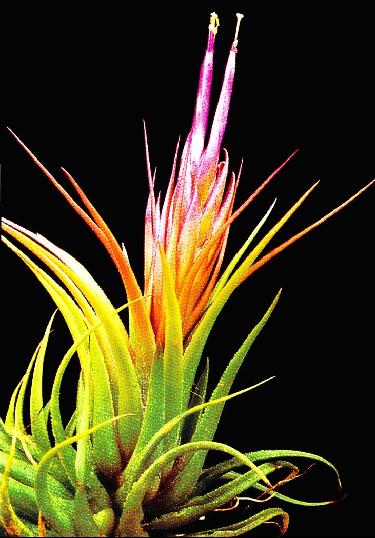
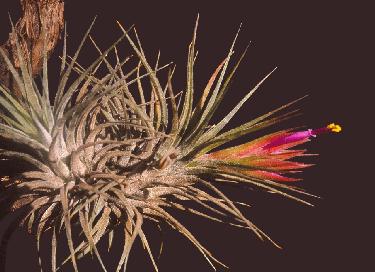
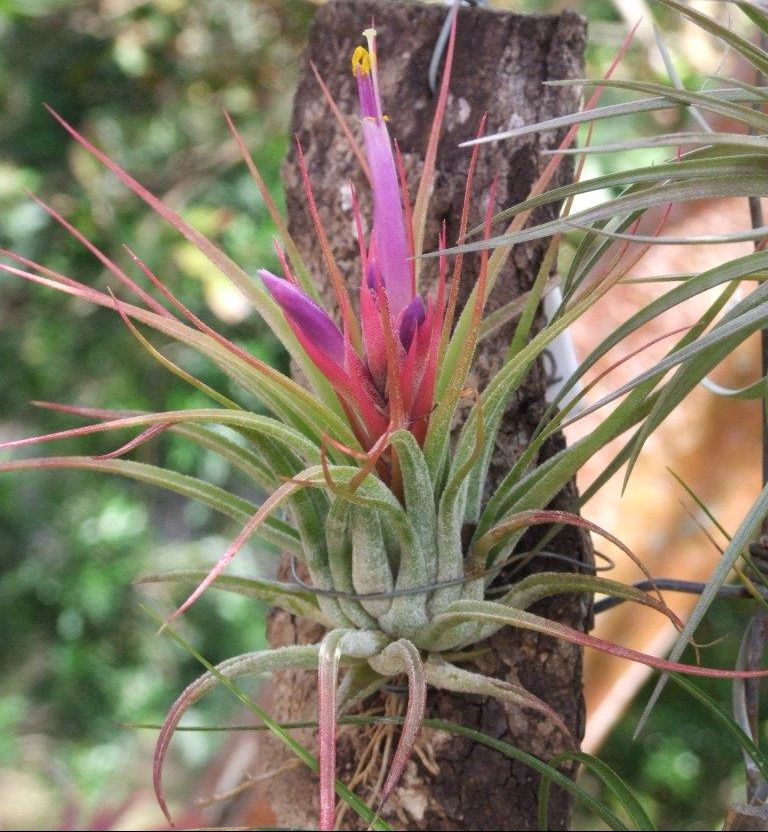
Detective Derek DD0511. |
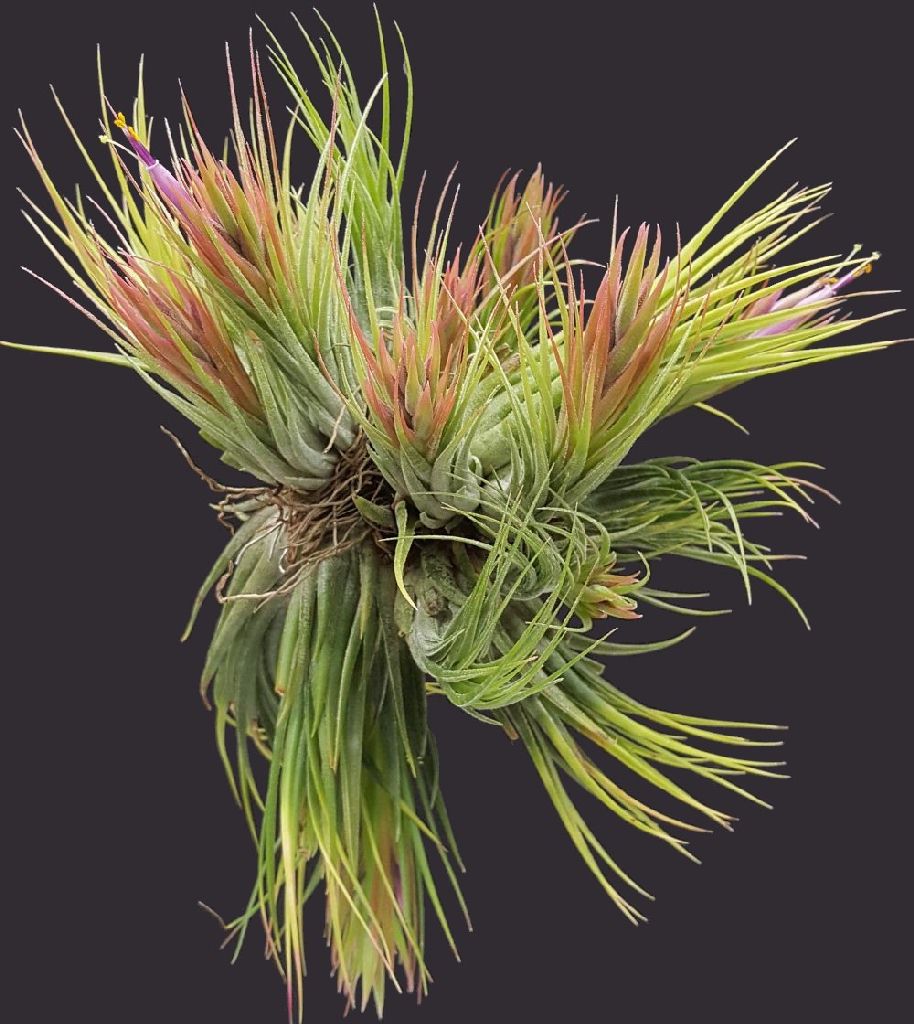
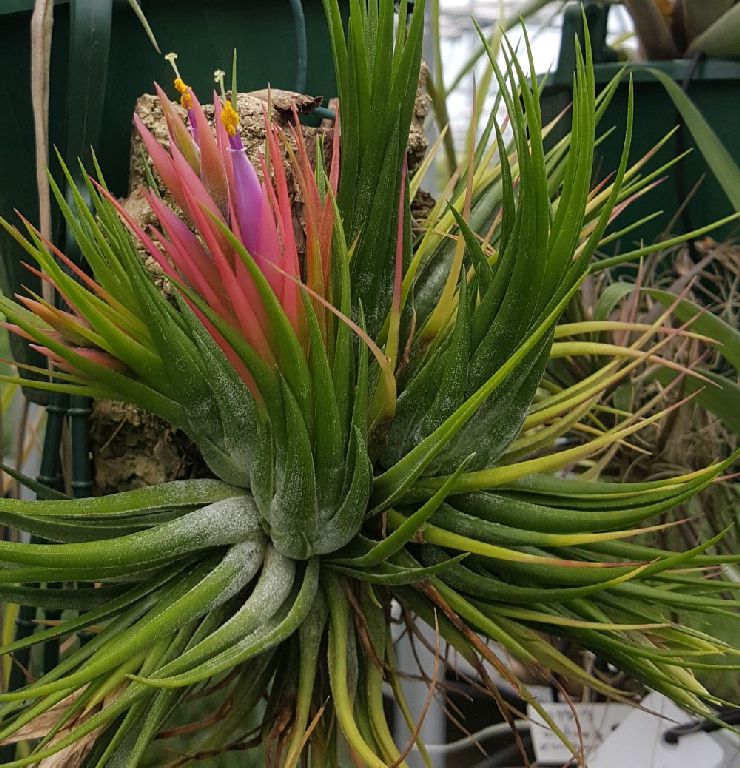
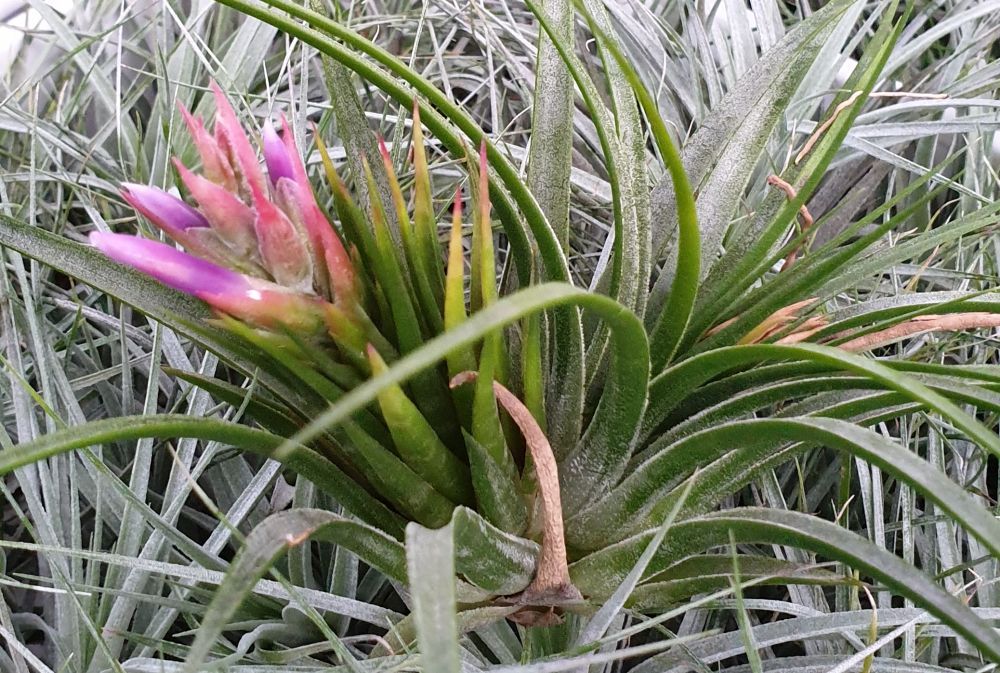
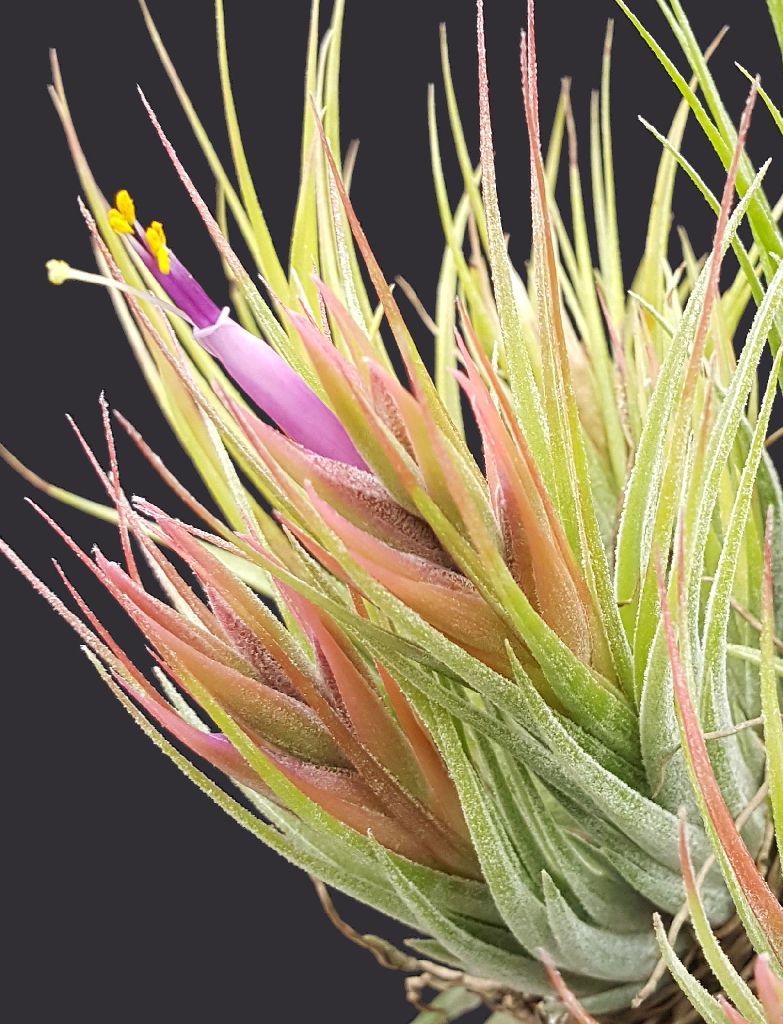
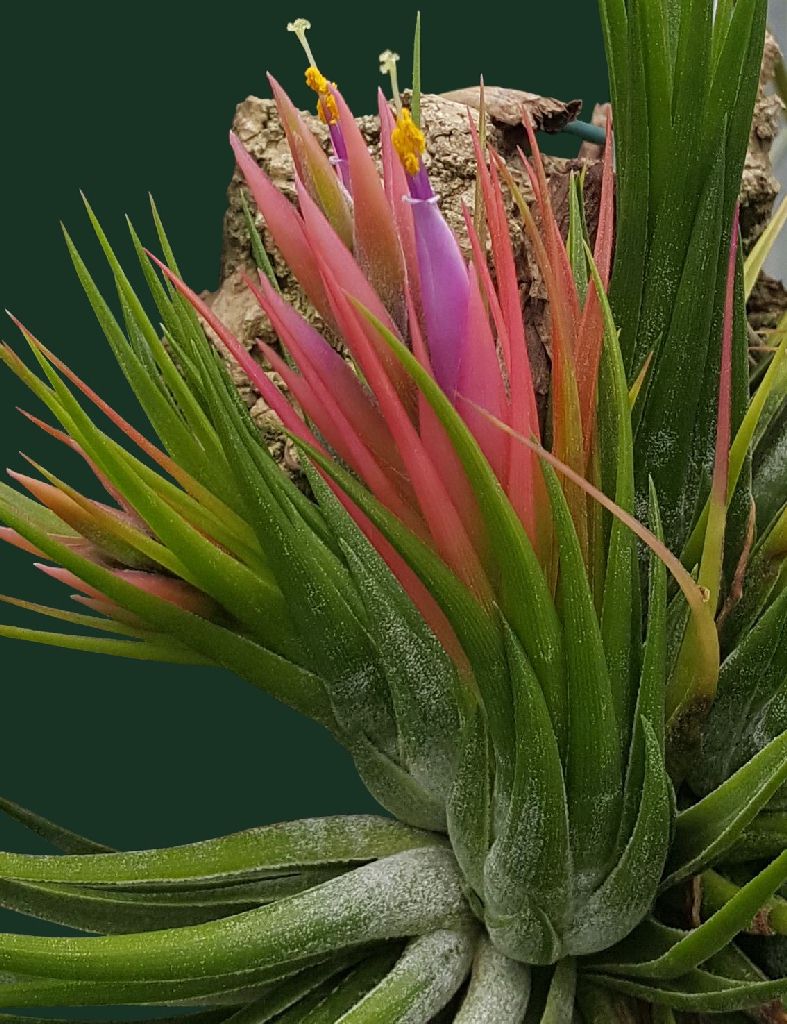
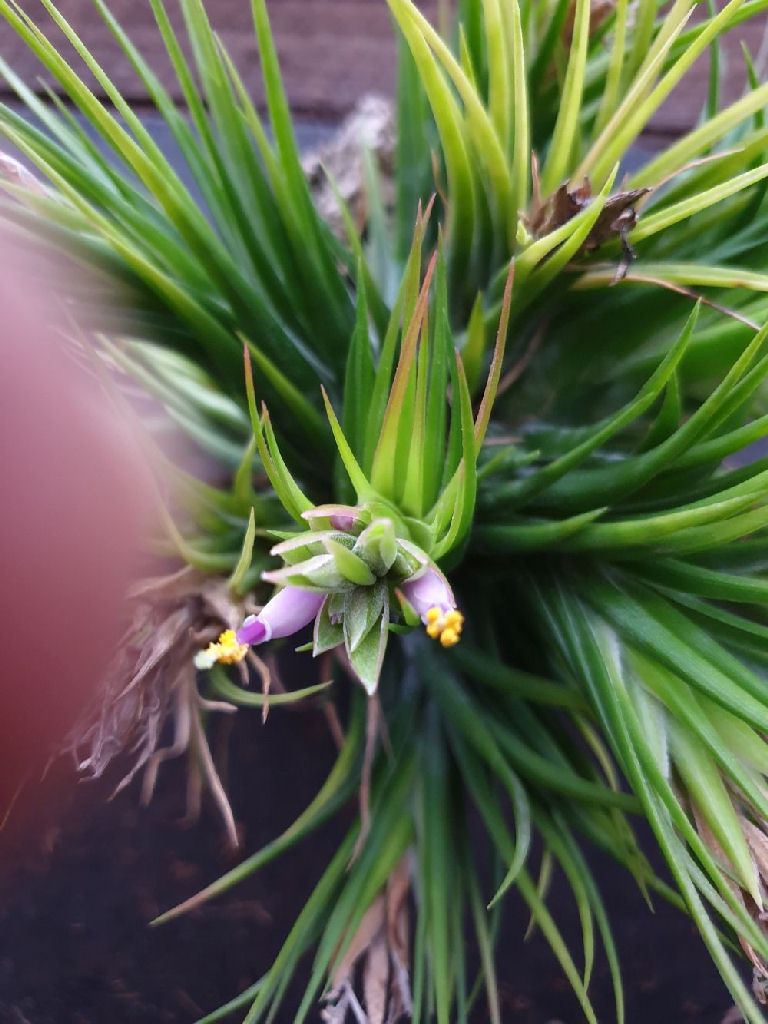
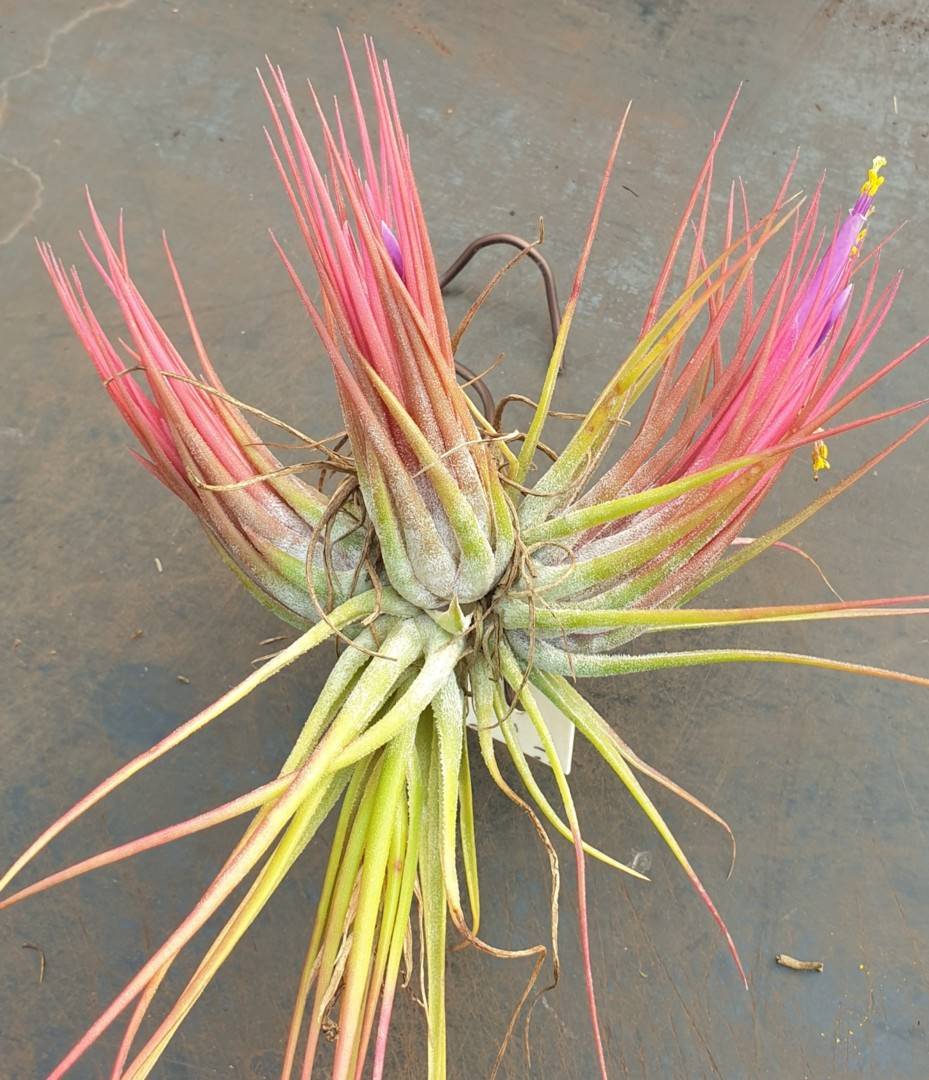
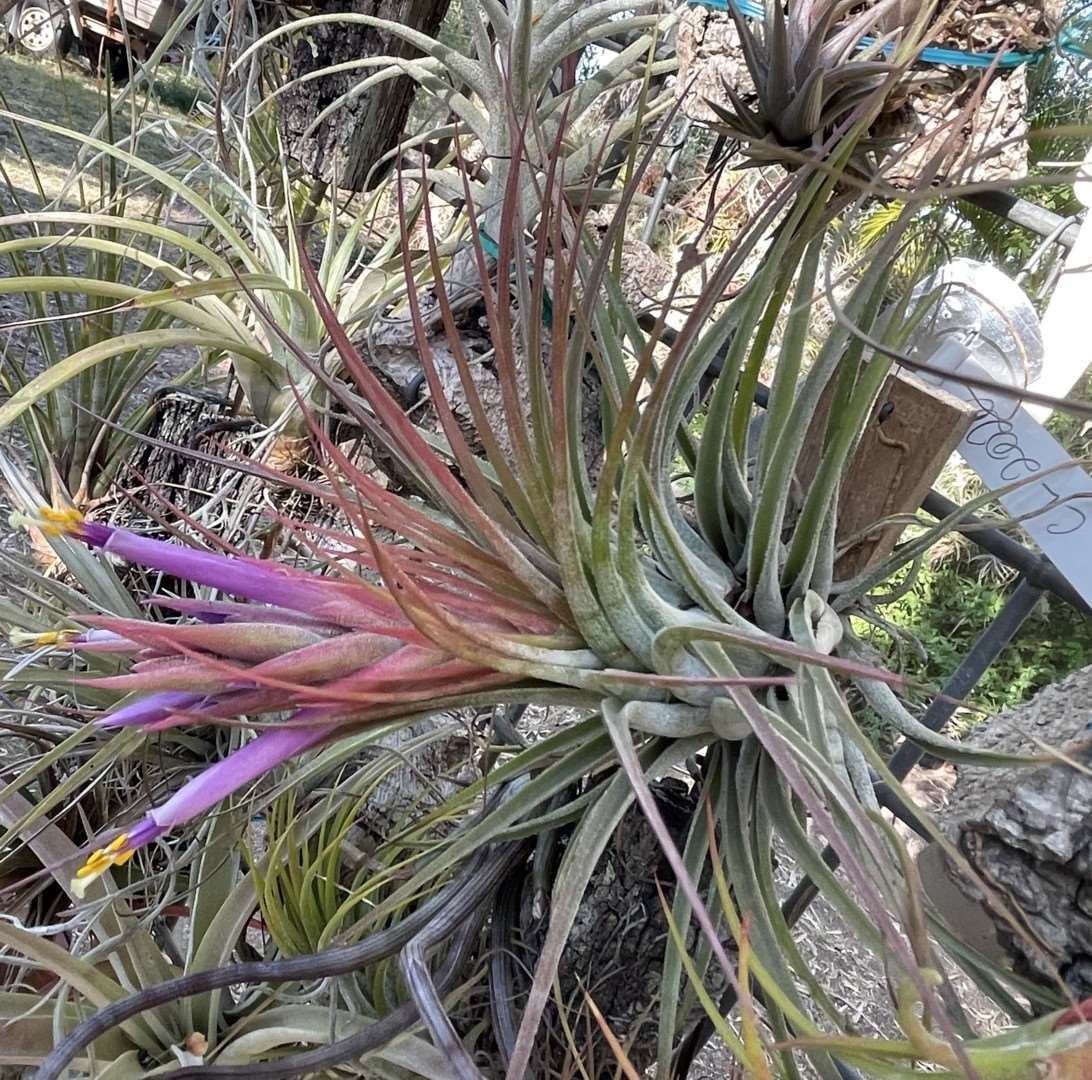
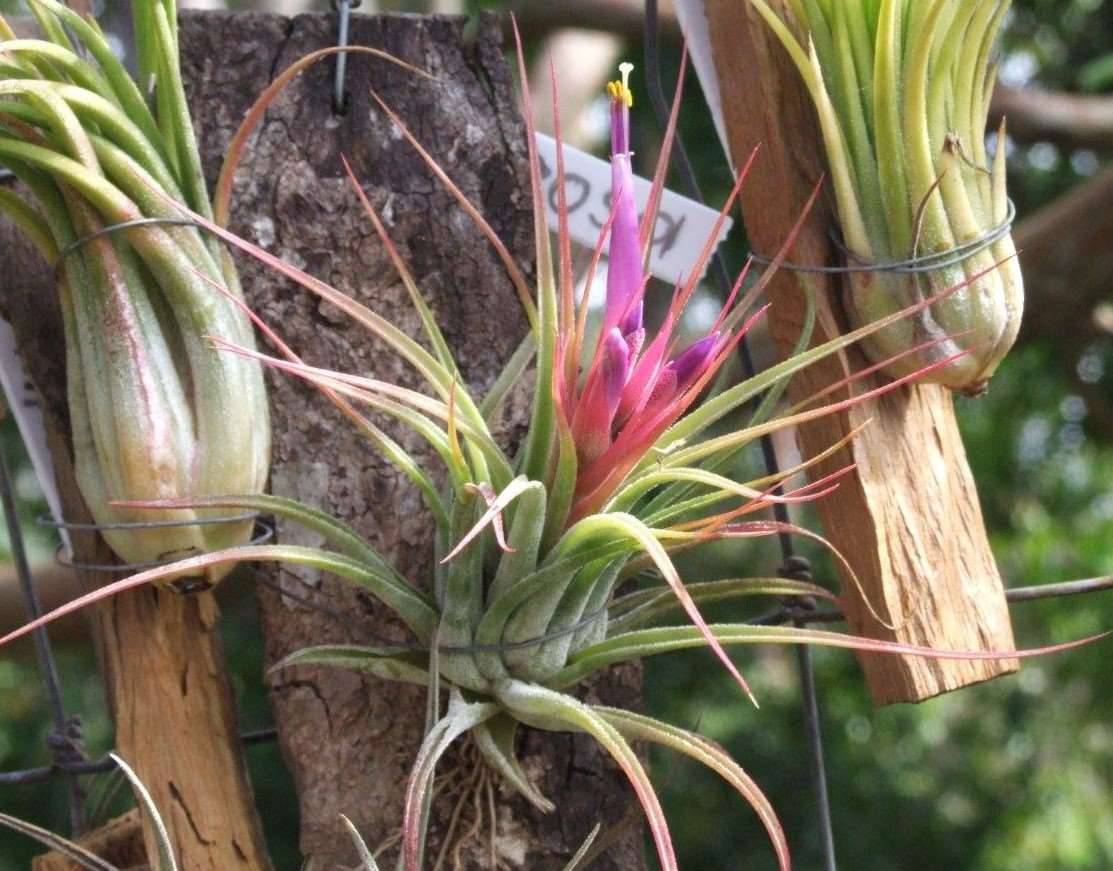
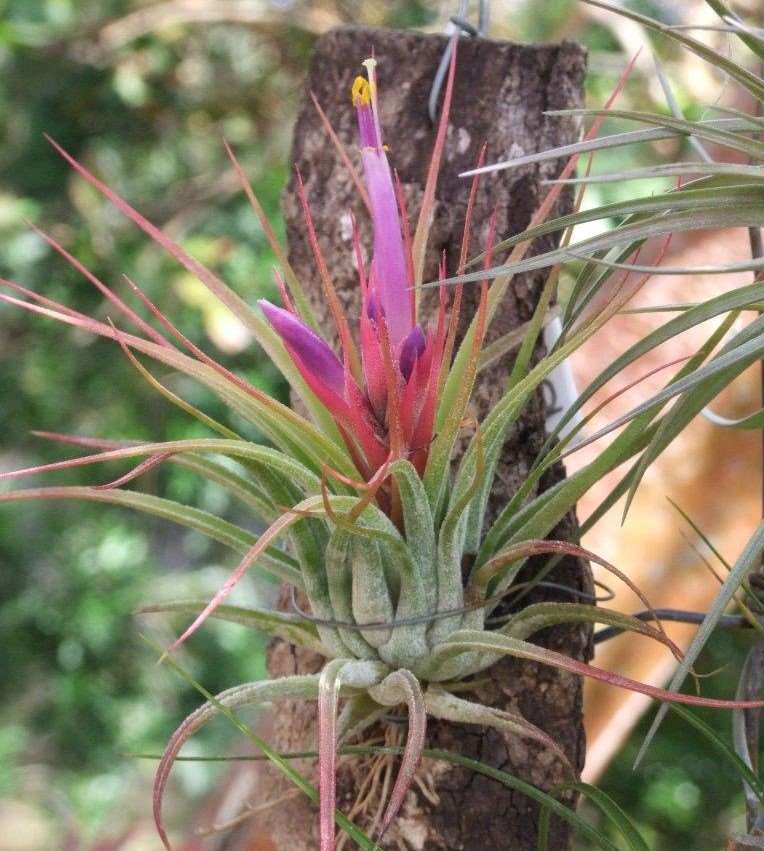
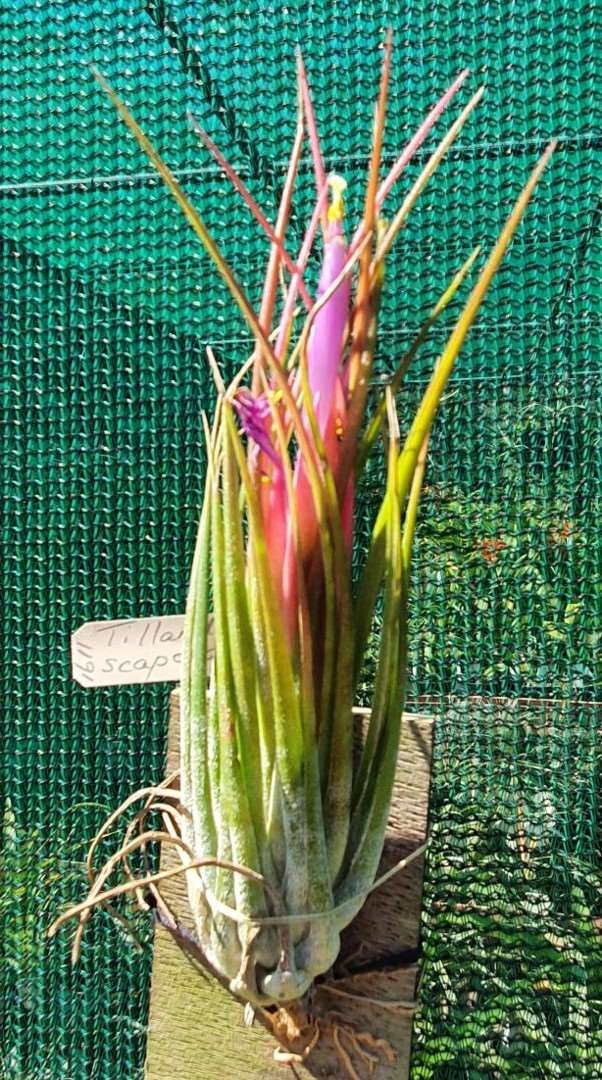
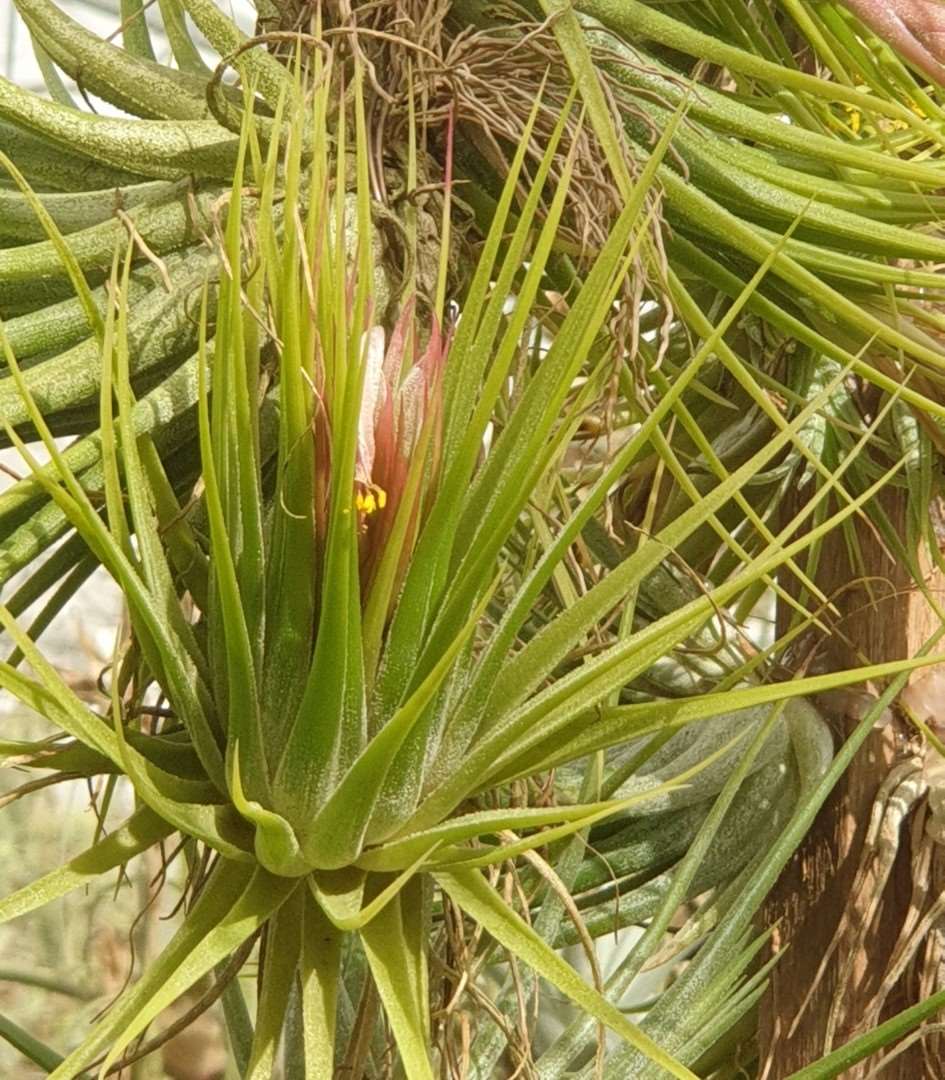
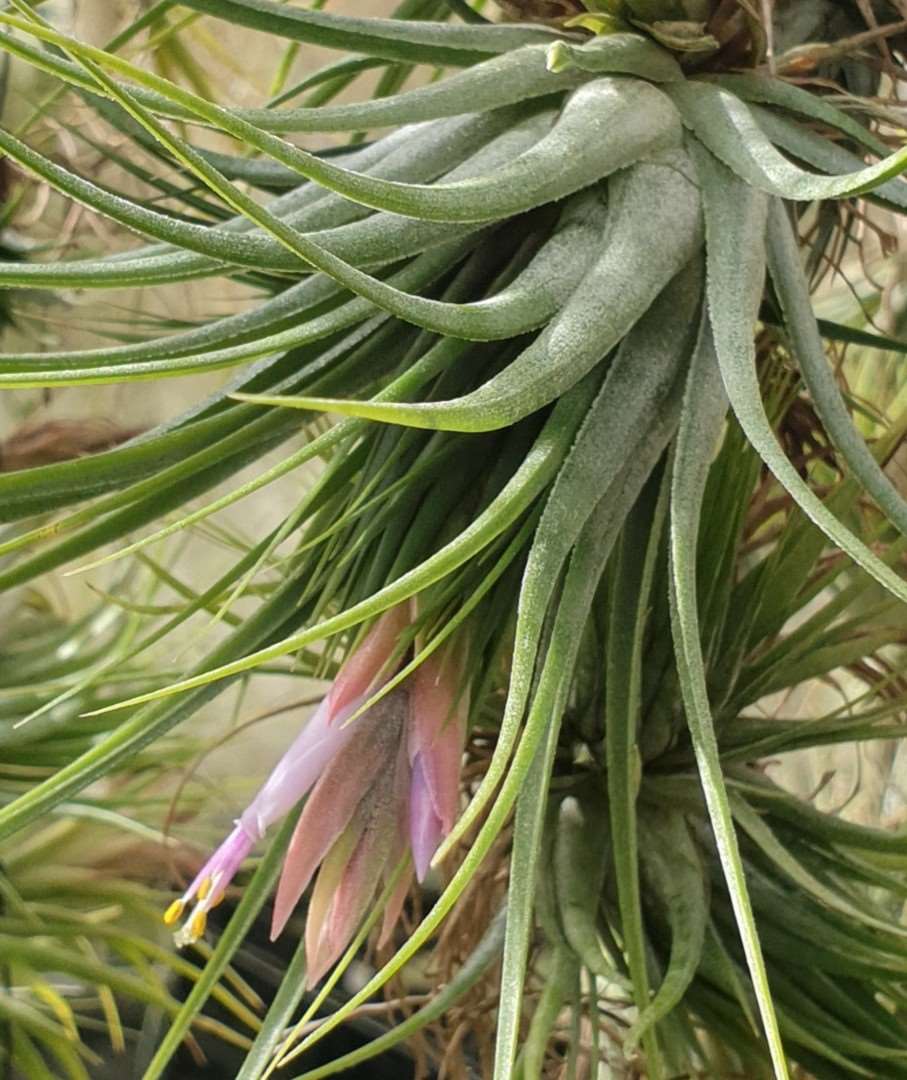
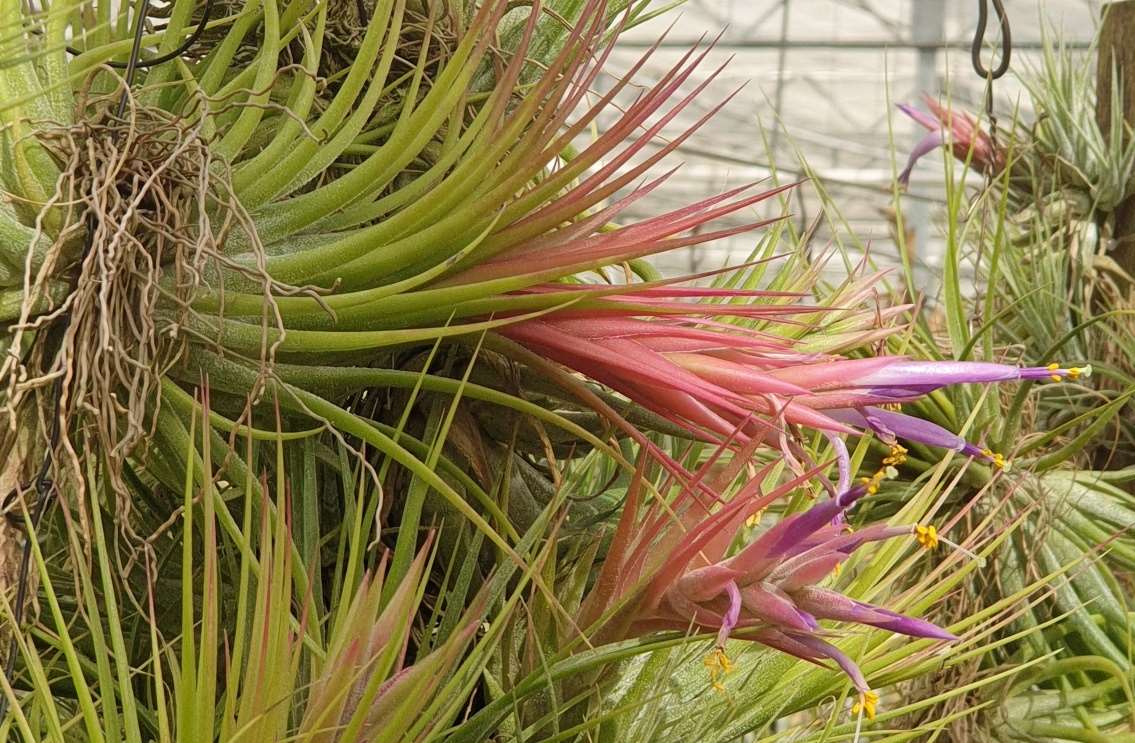
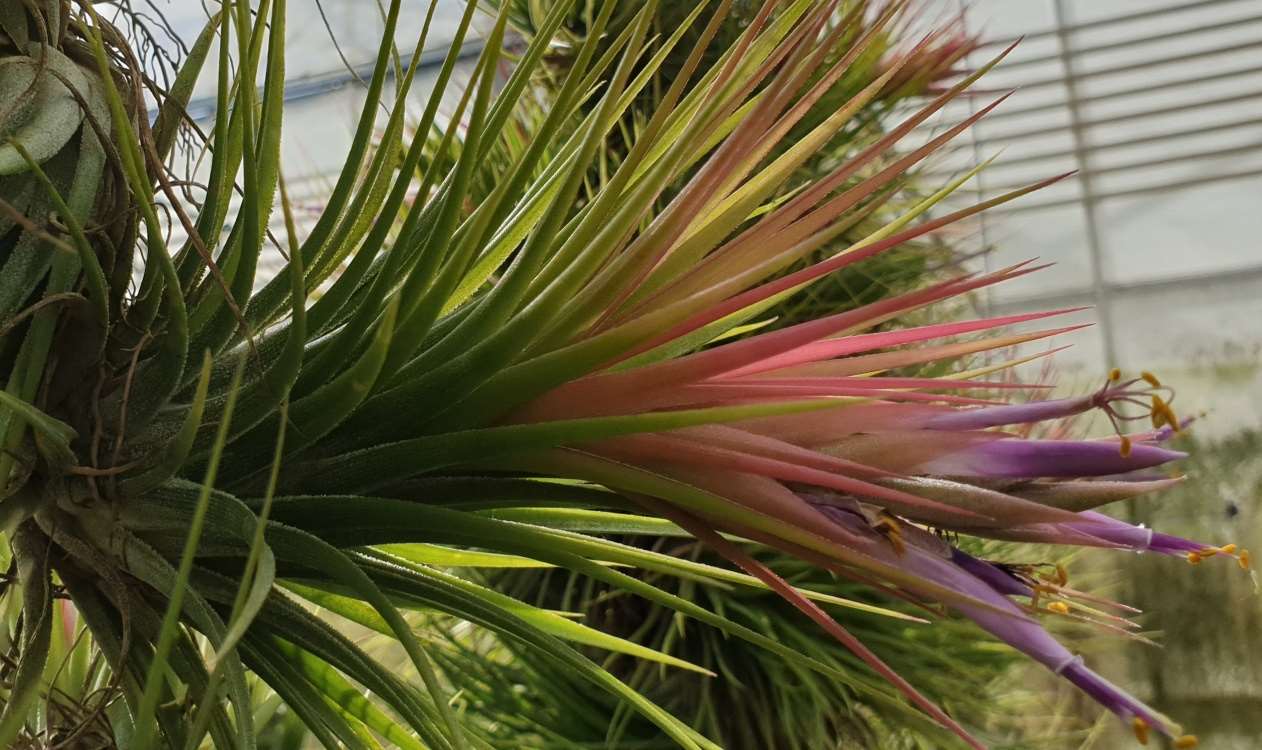
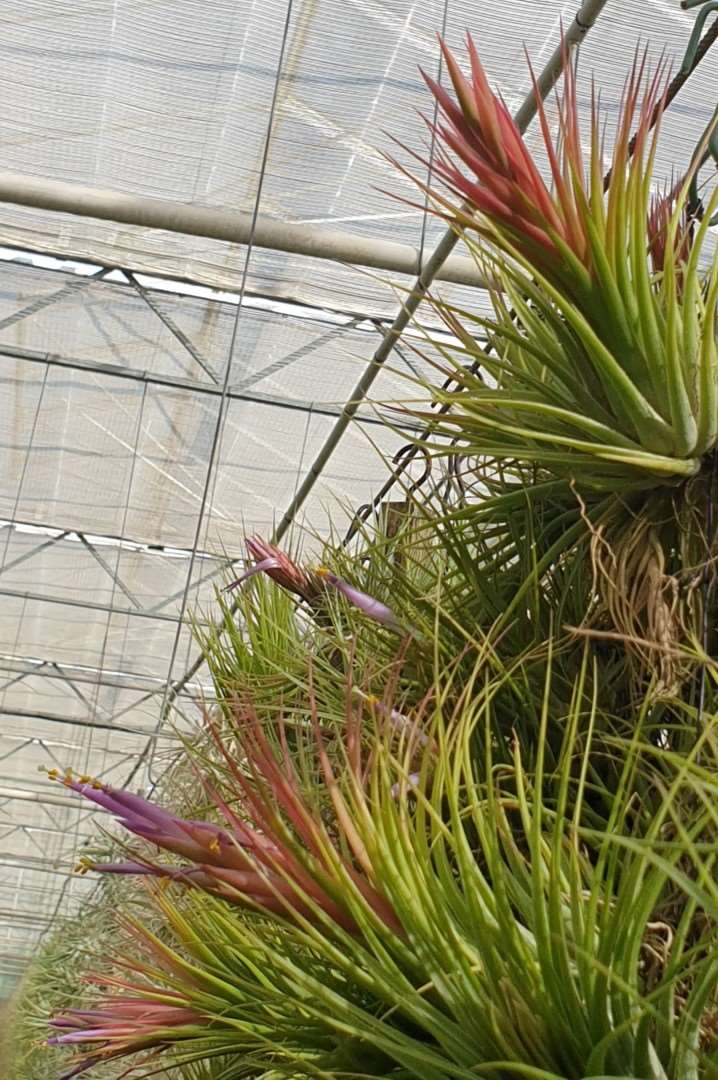

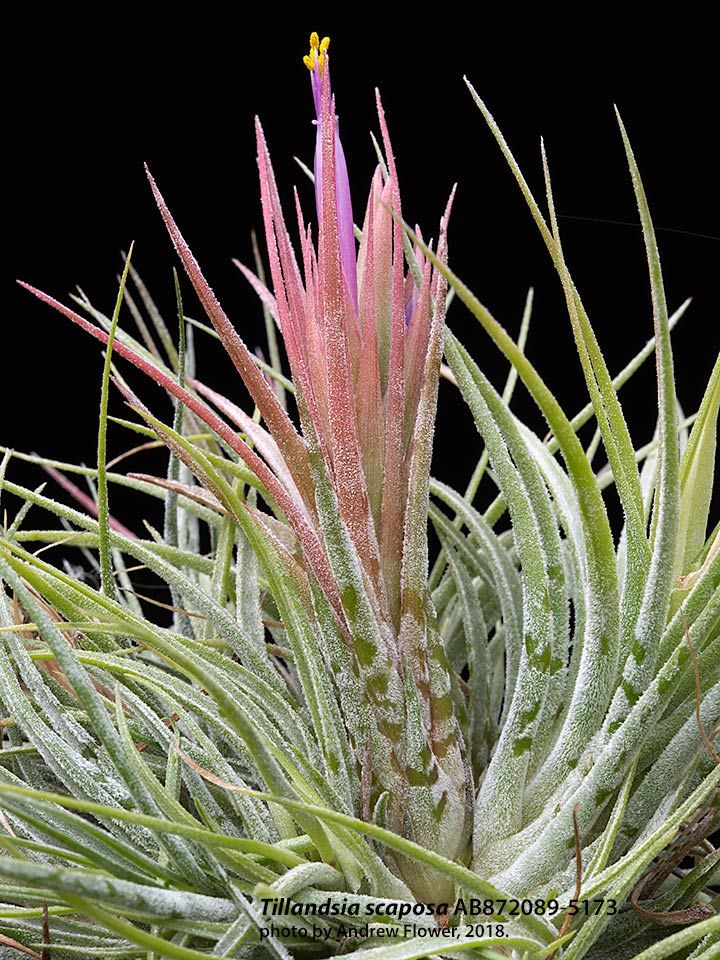
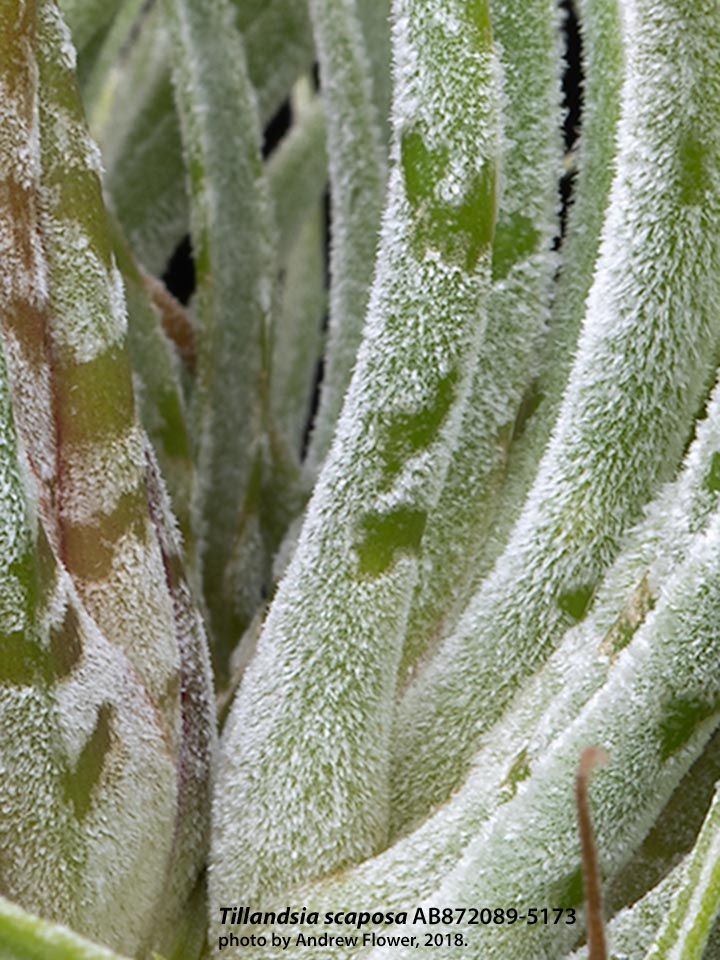
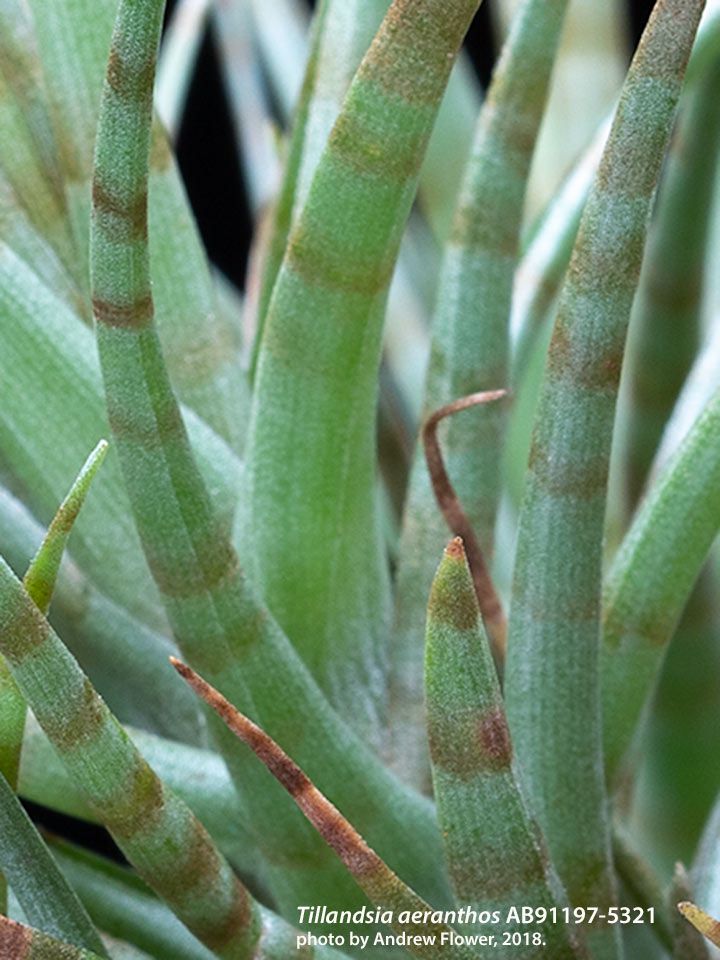
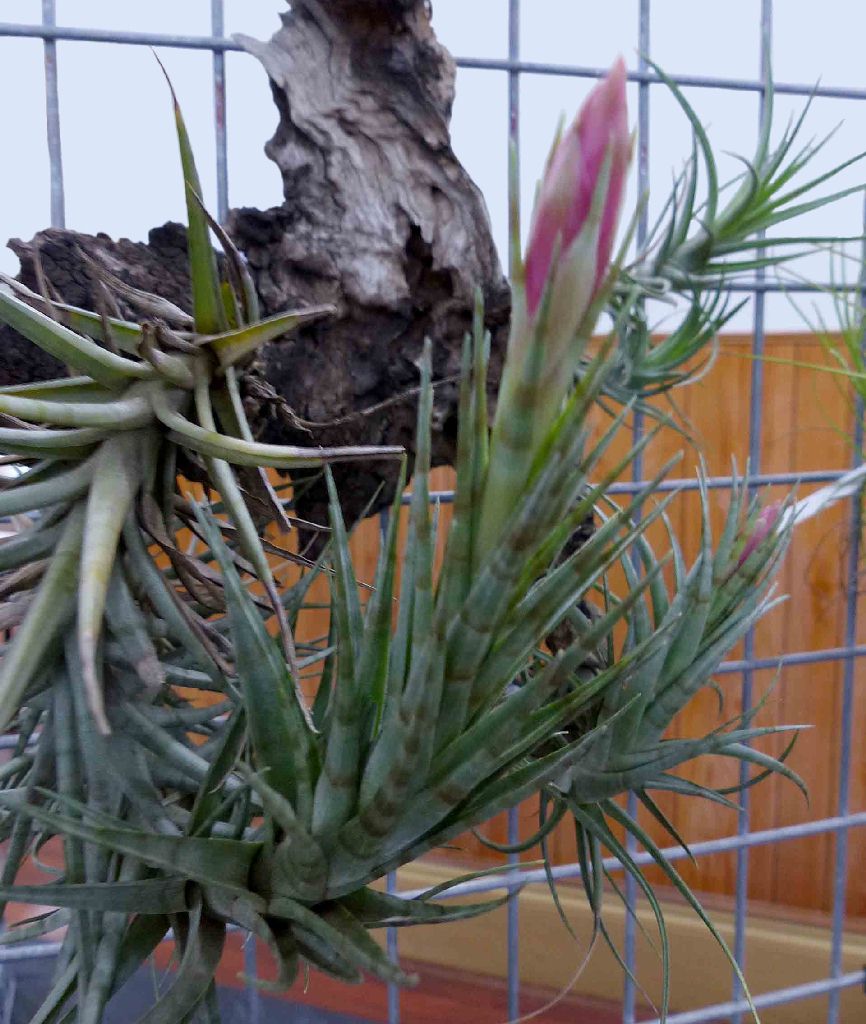
Plant stemless, growing often in large groups, forming an erect, somewhat bulbous rosette from numerous green, grey scaled leaves.
Leaves strong, to 9 cm long, both sides densely covered with grey, spreading trichomes.
Sheaths elliptical, about half as long as the blades.
Blades are about 5 mm wide above the sheath, narrow triangular acuminate, the outer ones green, the inner ones often deep red.
Peduncle short, however visible, covered by a few bracts similar to the inner leaves.
Fertile part of the inflorescence 4- 6 cm long, 2- 3 cm wide, with 3- 8 flowers laxly spirally arranged about the axis.
Primary bracts about as long or exceeding the floral bracts marginally, narrow-lanceolate, thin membranaceous, all are somewhat scaled at the tip.
Floral bracts 3-3.5 (to 4.1) cm long, 5- 10 mm wide, almost twice as long as the sepals, lanceolate acuminate, pink, adaxial glabrous, abaxial weakly or punctulate scaled.
Sepals 1.3 - 1.5 (to 1.8) cm long, lanceolate acuminate, adaxial keeled and very short connate, clearly scaled.
Petals 3.1 - 4.1 (6.1) cm long, tongue-shaped, in the upper part 4- 5 mm wide, elliptic, blue-violet, narrowing to 2 mm at the base.
Stamens protrude far from the flower.
Filaments arranged in two circles of different length, 3.5-6.5 cm long, in the upper part ovate, 1 mm in diameter and violet, narrow towards the base and becoming white;
anthers 2 – 2,5 mm long, 1 mm wide, fixed close to the base, yellow, pollen yolk yellow;
style 4-5 cm long;
stigma 2 x 2 mm, lobes narrow, white, a little spreading, papillose, not twisted;
seed capsule 3 cm long.
Tillandsia scaposa (LB Smith) R Ehlers Die Bromelie 3/1999: 64-70. 1999 See also Binomials 10, 2006 p100, and Die Brom 1: 6-9. 2000
Tillandsia ionantha var scaposa L. B. Smith, Lilloa 6: 384,pl. l,fig. 7. 1941.
Desc from S&D p910-3 (Info in brackets from Ehlers in Die Bromelie)
Plant stemless, usually in dense masses(an erect, bulbose, green rosette with grey trichomes.)
Leaves rarely over 6 cm long, covered with coarse cinereous spreading scales;
Sheaths elliptic, about half as long as the blade;
Blades narrowly triangular, subulate-attenuate, stout, 5 mm wide, the outer ones green, the inner deep red in life.
Scape short.
Inflorescence appearing to be a simple abbreviated spike with polystichous flowers but actually a reduced panicle with the axes aborted and the spikes reduced to a single flower each; (with a distinct stem, simple, polystichous, {In rare conditions it becomes a compound inflorescence} laxly elongate with 3-8 flowers)
Primary bracts lance-ovate, acute, equaling or exceeding the sepals, membranaceous, lepidote toward apex.
Floral bracts like the primary bracts but shorter than the sepals (3-3.5 cm long to 7 mm wide, lanceolate acuminate, inside glabrous, outside pink, weak mostly punctulate lepidote.)
Flowers sessile, erect.
Sepals lanceolate, acute, 16 mm long, membranaceous, free, the posterior carinate, short-connate; (1.3-1.5 cm long, the posterior ones keeled and joined for a very short way {almost free?}, distinctly lepidote.)
Petals erect, over 4 cm long, violet, the claw linear, the blade broadly elliptic, subacute; (3.5-3.8cm long, blue-violet.)
Stamens and pistil long-exserted.
Capsule subcylindric, acute, 3 cm long.
Type. Standley 63065 (holotype GH, isotype F), Antigua, Sacatepequez, Guatemala, Nov 1938- Feb 1939.
Distribution - spread through Central America, all of Guatemala and also comes from San Salvador and Honduras. Is not endemic to Mexico.
The plant is mostly in high areas with temperate, moist climate or in cloud forest, settling predominantly on oak and pine trees.
Material studied - From Guatemala EG 920202 near Antigua leg K & R Ehlers Feb. 1992.
Other plants from Guatemala flowering in the Ehlers collection obtained from Meyer & Femo. Widely different plants came from Honduras and San Salvador.
All plants prove to be almost uniform within the normal wide variation.
From S&D
DISTRIBUTION. Epiphytic, 1500-1950 m alt, Guatemala.
GUATEMALA. SACATEPEQUEZ: Volcan de Fuego, Mar 1892, Smith 2794 (US); Antigua, 1938-39, Standley 58817 (F, GH); 27 Jan 1939, Standley 63751 (F, GH); 20 Feb 1963, Hobbs s n (US); Pastores, 14 Dec 1938, Standley 59956 (F); Dueiias, 21 Jan 1939, Standley 63185 (F). CHIMALTENANGO: San Jose Pinula, 2 Mar 1958, Foster 3028 (US). ESCUINTLA: Palin, 16 Dec 1938, Standley 60107 (F, GH).
Description for Renate’s latest article in Die Brom 1: 6-9. 2000
Plant stemless, an erect, sub-bulbose, green rosette with grey trichomes, usually in dense masses
Leaves rarely 5-14 cm long, covered with coarse cinereous spreading scales;
Sheaths elliptic, to 2-3.5 cm long, 1-1.5 cm wide, about 1/3 as long as the blade or shorter;
Blades 6-11 cm long, 2-5 mm wide, narrowly triangular with a filiform tip, subulate-attenuate, stout, the outer ones green, the inner deep red when flowering.
Scape short, 1-3 cm long.
Inflorescence with a distinct stem, simple, appearing to be a simple spike with polystichous flowers with 3-8 flowers, but actually a reduced panicle with the axes aborted and the spikes reduced to a single flower each; In rare conditions it becomes a compound inflorescence, laxly elongate.
Primary bracts lanceolate, acuminate, always exceeding the floral bracts and the sepals, membranaceous, lepidote toward apex.
Floral bracts like the primary bracts much surpassing the sepals, (to twice as long) 3-3.5 cm long to 4-6 mm wide, lanceolate acuminate, inside glabrous, outside pink, weak mostly punctulate lepidote.
Flowers sessile, erect.
Sepals lanceolate, acute, 14-18 mm long, 2.5-3 mm wide, the posterior ones carinate, nearly free or the posterior ones to 3 mm connate, membranaceous,
Petals erect, forming a tube, 3.5-3.9 cm long, the claw linear, the blade broadly elliptic, the tips slightly recurved, blue-violet getting white towards base.
Stamens and pistil long-exserted, filaments in two sets of unequal length, 4-4.5 cm long 0.8 mm wide, broadened near apex, violet, getting thin and white towards base,
anthers 3-3.15 cm long, versatile fixed 1/3 from base.
Style 4 cm long, thin. white,
stigma 2 x 2 mm, lobes erect, papillose.
Capsule subcylindric, acute, 3 cm long.
Clarification in J. Brom. Soc. 38: 165. 1988 Note that Ehlers (1999) treats T. kolbii as a separate taxon possibly of hybrid origin.
The short illustrated note on Tillandsia ionantha in the March-April Journal requires a clarification. Both figures 7 and 8 represent Tillandsia ionantha var. ionantha. This is a quite variable taxon ranging in size from 2 to nearly 15 cm in height. Tillandsia ionantha is distributed over a wide area from northeastern Mexico south to central Costa Rica in hot, seasonally dry habitats. The greatest range of variation seems to occur in Mexico and several odd types have been given cultivar names.
In addition to the typical variety, a long, caulescent, lithophytic population has been described as var. vanhyningii. It is restricted to the state of Chiapas in southern Mexico.
A third variety characterized by a scapose, occasionally compound inflorescence has been described as var. scaposa. As this plant has little in common morphologically with T. ionantha and occurs at much higher elevations in pine-oak cloud forests perhaps a better designation is T. kolbii described by Till and. Schatzl in Plant Systematics and Evolution 138, pages 259-262, 1981.
Tillaridsia kolbii (T. ionantha var. scaposa) has, to the best of my knowledge, never been illustrated in the Journal. Collectors who acquire this plant (under either name) should be advised that conditions suitable for T. ionantha may be fatal to T. kolbii. Keep it damper and much cooler.
Harry E. Luther, M. B. Foster Bromeliad Identification Center The Marie Selby Botanical Gardens, Sarasota, Florida
What has taken a long time, finally comes good - Tillandsia kolbii W. Till & Schatzl and Tillandsia scaposa (L.B. Smith) Ehlers by Ehlers in Die Brom. 1: 12-25. 2010.
Almost 30 years ago Tillandsia kolbii Till et Schatzl from Oaxaca was published. Since then the species status was discussed again and again and was disbelieved by experts. In addition it was very confusing that on and off in the trade, plants were offered as T. kolbii, which in reality were T. scaposa. After the publication in 1981 I must confess that I was also not completely confident, that it was a 'good' species. For a long time I was of the opinion that T. kolbii was only a somewhat stunted form of T. ionantha var. scaposa.
Therefore, I conducted a long correspondence with Walter Till about this issue. The purple-violet petals were one of the main reasons for the doubts. All plants from the type locality I have examined, showed the petals as being always white. After intensive studies for several years I now believe that this plant has developed in a small ecological niche endemically near Copala. In the immediate proximity there is a very small form of T. matudae which seems to share with T. kolbii a range of characters, and I could easily imagine that it was originally a natural hybrid with T. kolbii, and has established itself meanwhile as a species. The indication of the hybrid origin could be also the variability, since plants occur with white as well with violet flowers, and the stamens in some are equally as long as the petals and others exceed thc floral tube by 2-3 mm.
I have been many times to the location of T. kolbii in Oaxaca where the plant is dispersed in a very restricted area close to Copala. On no account is it simply a case of finding plants on scattered trees and bushes near Copala. ln 1982, I was with my husband Klaus and Gerda Haugg in this area. As Gerda had been to the type locality with Stefan Schatzl in 1979, we thought it would be easy to collect this new tillandsia, but we looked for hours and found only two plants. However, I succeeded on later trips in seeing a whole number of plants and to collect some. After we had found out that they are growing only on umbrella-acacias, it was somewhat easier to track down T. kolbii. T. kolbii grows in its neighbourhood with T. fuchsii W. Till, T. magnusiana Wittmack, T. plumosa Baker, T. mexicana L. B. Smith, T. copalaensis Ehlers, T. juncea (Ruiz & Pavon) Poiret, T. matudae L. B. Smith, T. butzii Mez, T. bourgaei Baker, and T. lagunaensis Ehlers.
Chronology
In 1981 Dr. Walter Till described together with Stefan Schatzl, director of the Botanical Garden Linz, Tillandsia kolbii from Oaxaca. It was published in Plant Systematics and Evolution, 138, 259- 262. This journal is not readily accessible, so I wrote a short description of T. kolbii W. Till & Schatzl when I described T. delicata in Die Bromelie 1999(3), and showed the differences to T. ionantha var. scaposa L. B. Smith. After my comparative studies I concluded that T. ionantha var. scaposa L.B. Smith had large deviations from the typical form of T. ionantha Planchon and that we should regard T. scaposa as an autonomous species.
As a conclusion of my long standing studies I propose to accept T. kolbii as species and T. scaposa to get the species status:
Tillandsia kolbii W. Till & Schatzl = species
Tillandsia ionantha var. scaposa L. B. Smith = Tillandsia scaposa L. B. Smith stat. nov.
1999 - Harry Luther does not accept my proposal.
Unfortunately, Harry Luther did not follow my suggestion, and “The Alphabetical List of Bromeliad Binomials" (The Marie Selby Botanical Gardens, Sarasota, Florida, USA, May 2000) only showed T. kolbii W. Till & Schatzl with T. ionantha var. scaposa as a synonym. Admittedly this recognized that the var. scaposa had been raised to species status. It seemed however paradoxical to me that a plant, which
is quite different according to my opinion from T. scaposa and which grows in a totally different distribution area, should be synonymous to T. ionantha var. scaposa, and therefore T. kolbii is not acknowledged as its own species.
2005 - Flowering Tillandsia kolbii can be investigated in the Botanical Garden Gottingen
At our meeting in June 2005, we saw a flowering T. kolbii in the Botanical Garden Gottingen with Jurgen Lautner. The petals were pure white with the stamens enclosed in the flower tube. Of course, a detailed discussion occurred between the Tillandsia friends present, including: Peter Bak, Andreas Boker, Eric Gouda, Lieselotte Hromadnik, Jurgen Lautner, Uli Lautner, Lydia Kohres and many others: universal agreement this plant is never ever the same as T. scaposa. I had just arrived home when I spoke to Pia Rosslein who had not been able to attend the meeting. She also agreed with us completely. T. kolbii should be considered as being a species in its own right.
2005 - Plants of the type-collection can be studied in the Botanical Garden Linz
On the occasion of the Annual General Meeting of our society on September 9-11, 2005 in Linz I was luckily able to see the original plants from the type collection of Stephan Schatzl in the collection of the Linz Botanical Garden. Three plants had an inflorescence already well developed, but unfortunately there were still no open flowers so that we could not yet recognize the flower colour. Lydia Kohres mentioned that all T. kolbii in her collection have white flowers. Curator Franz Fuchs, who had tended these plants over the decades, reported that the plants from the type collection in past years had flowered white but also some had flowered violet or pale violet. The plants are completely the same in habit and in the flowering characteristics of the inflorescence. The fact of the variable flower colour would be a further evidence for my supposition that T. kolbii could be of recent hybrid origin.
W. Till however already quotes in his description that the seedlings raised in Linz show to be uniform in their habit which was confirmed by Mr. Fuchs after long years of cultivation. So, it being a primary-hybrid population can probably be excluded.
2005 - A new initiative from Harry Luther
After examining a whole range of plants over a long time period and after due consideration I am convinced that T. kolbii is a 'good' species that grows in a small ecological niche in a very restricted area. A certain similarity exists with T. delicata Ehlers, which also populates only a quite restricted area in Oaxaca. The differences to T. kolbii are however very pronounced and are presented with the description.
The similar Tillandsia scaposa cannot be found in Mexico (except some scattered locations near the border to Guatemala), it is distributed only in Guatemala, Honduras, El Salvador and Costa Rica.
Therefore I contacted Harry Luther again and sent him photos of T. kolbii and asked him to reconsidcr his point of view.
2005 - Harry Luther accepts my proposals
I was very glad to get the following answer per e-mail: “Dear Renate, you should publish your pictures and observations. I can see that T. kolbii is not related to T. scaposa. It is probably related to T. plagiotropica and T. kammii. Butcher has sent me a picture with violet petals years ago. Greetings, Harry".
And, in his list of May 2006, T. kolbii is presented as its own species as well as T. scaposa. It took a load off my mind. So now I would like to follow Harry Luther's advice and publish the original description including drawings of details from Walter Till, and photos of T. kolbii, which I collected at the type locality on Dec 1, 1999 (EM991603).
Tillandsia kolbii W. Till & Schatzl 1981
Typus: Mexico. Oaxaca, Sierra Madre del Sur, prope pagum Copala (ca. 40 km WSW Tlaxiaco) 1750-2000 m s. m.; in quercis. Legit S. Schatzl, 1979; Holotypus WU, plantae viventes loci typi in horto botanico Lentiae (Linz. Austria).
Plant flowering 10 cm high, stemless.
Leaves in a dense rosette, bent slightly to the left, quite thin and rather soft, bright-green, densely white scaled, up to 9 cm long;
leaf-sheath brownish on the inside, not distinct from the blade, 7-8 mm wide, with more or less rolled up margins;
blade narrow triangular, fine acuminate.
Peduncle short, 3-4 cm long, densely covered with foliate peduncle bracts, pale-green to pale purple at the tip.
Inflorescence erect, simple, distichous (annotation Ehlers: in most cases the flowers are laxly spirally arranged), 4 cm long, 1.8 cm wide, 5 flowered;
floral bracts subfoliate, 3-3.5 cm long, longish, pale green, about 1.5 times as long as the sepals, not carinate.
Flowers subsessile;
sepals almost glabrous, all almost free, narrowly elliptic, blunt, green, whitish at the margin, membranaceous, half as long as the petals;
petals purple-violet, white in the lowermost third (or very often white), forming an upright tube, 3.5 cm long.
Filaments slim, white, with violet thicker end, weakly twisted, virtually as long as the petals;
anthers short, 1 mm long, yellow, stigma green; style white;
ovary ovate, pale green.
The plants were collected by Stefan Schatzl, and named in honour of retired district magistrate Rudolf Kolb, Linz, for his service to the Linz Botanical Garden.
Tillandsia kolbii grows in a light oak forest and prefers the underside of stronger branches on not very high trees as habitat.
The species is in the subgenus Allardtia (A. Dietrich) Baker on the basis of their stamens somewhat included although the habit and above all the tubular corolla suggest the subgenus Tillandsia L.
The key by L. B. Smith (1977) leads in the first case close to T. matudae L. B. Smith, from which T. kolbii differs by the simple and erect inflorescence, as well as the dense scaled floral bracts. In the latter case, you could also link with T. velickiana L.B. Smith, but the species has narrow elliptical pale-green floral bracts, a short, though clear peduncle and violet-purple flowers. No other tillandsia has links with T. kolbii.
Differences between Tillandsia kolbii and T. scaposa respectively T. delicata
Though the plants bear resemblance to each other in the non-flowering state, there are marked differences between Tillandsia kolbii and T. scaposa as well as T. delicata.
Tillandsia kolbii differs from Tillandsia scaposa (L. B. Smith) Ehlers by the following characteristics:
Plant smaller. rosette composed from less, more narrow leaves, which are somewhat grey, usually not erect, often twisted or bent (not secund), floral bracts more densely and also adaxially densely scaled, sepals few scaled, petals often white or light violet, stamens enclosed in the flower tube or only a little exceeding. Furthermore, both species live in quite different areas: T. kolbii is restricted to a very small endemic area in Mexico, but T. scaposa is found all over Central America, however not in Mexico.
Tillandsia kolbii differs from T. delicata Ehlers by the following characteristics (characters of T. delicata in brackets):
Plant smaller, only 10 cm (15 cm) high, forming a rosette (dense pseudobulb); leaves shorter, thin, often twisted to the left (leaves longer, straight, almost upright, harder, sub-succulent with more clearly distinct blades); inflorescence with lax spirally arranged flowers (clearly distichous, wider, forming a red sword); floral bracts 1.5 times as long as the sepals, lanceolate, narrow, yellow-green (2-3 times as long, broad-ovate and to 3 times as wide as the sepals, adaxial less densely scaled with fine grey trichomes, abaxial not lepidote but glabrous, shiny red); petals only half as long, stamens equally long with the petals (protruding clearly from the flower).
Unfortunately, the climate has changed at the location so dramatically in the meantime, it has become much hotter and drier so that the plant, that loves some moisture, is almost no longer to be found. There could only be plants in collections in the quite near future, because in their natural habitat there seems little chance of them surviving. The trees are chopped down, corn is grown and the fields are often already left bare after 2 years.
Already in 1982 the type habitat, therefore only 3 years after the type collection, was almost completely cleared and destroyed. This was reported by Gerda and Erich Haugg, who had discovered the plant together with Stefan Schatzl in 1979. On the few remaining trees, only few plants grow and many of the tillandsias which grew here formerly are gone. In this dreamily beautiful area we had to witness how quickly the growing anthroposphere of the indigenous people, who require more and more natural landscape in Mexico, have a dramatic effect on the climate and the vegetation.
So Tillandsia scaposa gets a new status as a species: Tillandsia scaposa (L. B. Smith) Ehlers
Tillandsia ionantha var. scaposa L.B. Smith, was only briefly described by the author as follows:
plant stemless, leaves in large numbers, peduncle of the inflorescence short but evident.
The plant is now described in detail as follows.
Tillandsia scaposa (L.B. Smith) Ehlers, Die Bromelie 2000(1): 6-9
Syn. T. ionantha var. scaposa L. B. Smith
Typus. Standley 63065 (holotype GH, isotype F), Antigua, Sacatepequez, Guatemala, Nov 1938-Feb 1939.
Plant stemless, growing often in large groups, forming an erect, somewhat bulbous rosette from numerous green, grey scaled leaves.
Leaves strong, to 9 cm long, both sides densely covered with grey, spreading trichomes.
Sheaths elliptical, about half as long as the blades.
Blades are about 5 mm wide above the sheath, narrow triangular acuminate, the outer ones green, the inner ones often deep red.
Peduncle short, however visible, covered by a few bracts similar to the inner leaves.
Fertile part of the inflorescence 4-6 cm long, 2-3 cm wide, with 3-8 flowers laxly spirally arranged about the axis.
Primary bracts about as long or exceeding the floral bracts marginally, narrow-lanceolate, thin membranaceous, all are somewhat scaled at the tip.
Floral bracts 3-3.5 (to 4.1) cm long, 5-10 mm wide, almost twice as long as the sepals, lanceolate acuminate, pink, adaxial glabrous, abaxial weakly or punctulate scaled.
Sepals 1.3 - 1.5 (to 1.8) cm long, lanceolate acuminate, adaxial keeled and very short connate, clearly scaled.
Petals 3.1 - 4.1 (6.1) cm long, tongue-shaped, in the upper part 4-5 mm wide, elliptic, blue-violet, narrowing to 2 mm at the base.
Stamens protrude far from the flower.
Filaments arranged in two circles of different length, 3.5-6.5 cm long, in the upper part ovate, 1 mm in diameter and violet, narrow towards the base and becoming white;
anthers 2–2.5 mm long, 1 mm wide, fixed close to the base, yellow, pollen yolk yellow; style 4-5 cm long; stigma 2 x 2 mm, lobes narrow, white, a little spreading, papillose, not twisted;
seed capsule 3 cm long.
In rare cases compound inflorescences are reported (personal communication Pamela Koide), however it could also refer to natural hybrids. We ourselves have found different hybrids near the type localities, for example T. scaposa x T. rodrigueziana. ln the garden centre of Uwe Feldhoff in Guatemala, we could admire a row of hybrids, but hundreds of T. scaposa showed only simple inflorescences.
Tillandsia scaposa (L. B. Smith) Ehlers differs from T. ionantha Planchon var. ionantha not only in the distinct peduncle but also in the lax erect, narrower rosette, wider softer leaves, which are more sparsely covered with smaller trichomes, in a short pedicel and a laxly elongated inflorescence with spirally arranged flowers, sepals predominantly covered with small grey trichomes. The plant usually grows in higher altitudes in a moderate moist climate or in the cloud forest, predominantly on oaks and pines. T. ionantha usually grows on bushes and small trees, more rarely also on rocks, however often in arid, hot areas in lowland zones down to sea level.
The multiplicity of the deviant morphological characters and the clear habitat differences are the reason that this plant is treated now as a species in its own right.
Range
The type locality is Guatemala, Antigua, Sacatepequez (Standley 63065, 1938). The range is restricted to Central America, the species is not found in Mexico.
Tillandsia scaposa grows epiphytically in woodland at altitudes of 1500 - 1950 m. Above all in Guatemala, it is wide-spread, further occurring in Costa Rica, El Salvador and Honduras. The plant prefers cloud forests in higher altitudes with moderate, moist climate. All examined plants proved uniformly within the normal range of variation. Plants from El Salvador or Costa Rica have the same characters as plants collected by us near the type locality at Antigua in Guatemala. Only plants imported from Honduras had an inflorescence somewhat larger in all floral parts.
Examined material: from Guatemala EM920202 close to Antigua, leg. Klaus and Renate Ehlers, Febr. 1992; as well as further plants from Guatemala flowering in col. Ehlers, furthermore imported plants without exact origin from Honduras and El Salvador.